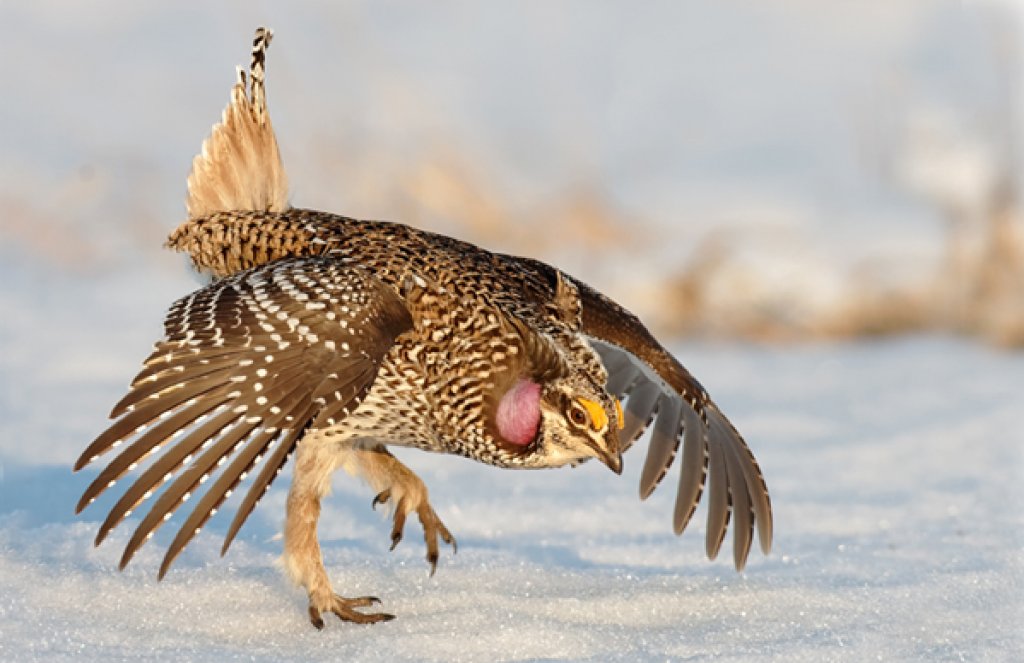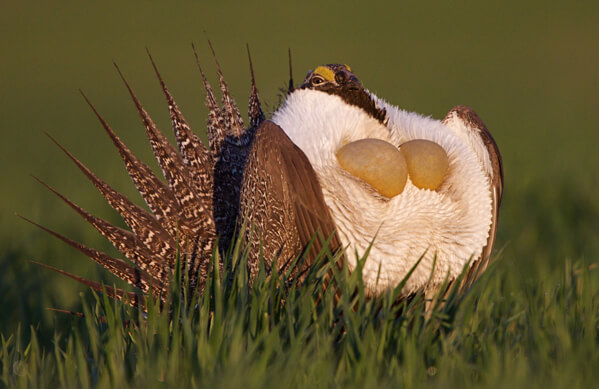About
The Sharp-tailed Grouse is closely related to Lesser and Greater Prairie-Chickens, but has several characteristics that set it apart: The “Sharptail” has a white-edged, wedge-shaped tail with two long central feathers that give it an elongated, spiky appearance. Also, the male has an inflatable purple air sac on its neck, unlike the yellow or orange neck sacs of male prairie-chickens. In general, this grouse's pale belly and spotted plumage give it a frosted appearance distinct from the darker, barred plumage of its near relatives.
The Sharp-tailed Grouse's distribution extends much farther north than those of its prairie-chicken cousins, and this species has special adaptations for colder climes.
Ready for Winter
Like another north-ranging relative, the Ruffed Grouse, the Sharp-tailed Grouse has adaptations that allow it to survive snowy winters and frigid temperatures. Its nostrils and legs are feathered to help keep out the cold, and comb-like projections called pectinations edge its toes. These pectinate toes act as snowshoes, allowing Sharptails to walk atop snow and roost comfortably on snow-covered branches. At night, Sharp-tailed Grouse may also burrow into the snow for extra warmth.
Songs and Sounds
Male Sharp-tailed Grouse make a variety of cooing, gobbling, and cackling vocalizations while displaying, accompanied by nonvocal sounds produced by the birds rapidly rattling their tail feathers and stamping their feet.
Listen to male Sharp-tailed Grouse dancing and vocalizing on a lek at Seney National Wildlife Refuge, Michigan:
Watch male Sharp-tailed Grouse on a lek here!
Breeding and Feeding
Foot-Stamping Displays
Like Greater Sage-Grouse and prairie-chickens, male Sharp-tailed Grouse come together at gatherings known as leks to display for potential mates. Up to 20 males at a time will assemble on an open, grassy rise to perform a complex “dance,” with spread wings, inflated purple neck sacs, raised tails, and rapidly stamping feet that tap up to 20 times a second! Displaying males spin in circles, rush forward, and leap into the air. Each male defends his own small territory within the lek. Pitched battles often break out at territory boundaries, with rivals pecking and scratching at each other, often to the point of injury. The most dominant males in the lek mate with many females per season.
Females visiting the lek choose a male, mate, then leave to nest and raise their young nearby. Each female nests on the ground in a shallow depression under grassy cover, usually near shrubs. The clutch size ranges from 10 to 13 eggs, which the female incubates for roughly three weeks. The chicks, already covered in down, hatch with their eyes open. They usually leave the nest within a day, although they stay near their mother for several months.
Arboreal Grouse
The Sharp-tailed Grouse will feed in trees as well as on the ground, often flying from tree to tree while foraging. This arboreal habit is particularly handy during the winter, when snow may completely cover food sources on the ground. Adult Sharp-tailed Grouse mainly eat plant materials such as buds, shoots, berries, and seeds, but will add insects such as ants, crickets, grasshoppers, and beetles to the menu during the summer. As with other grassland bird species, from Dickcissels to Swainson's Hawks, insects provide an important source of protein for growing chicks.
Sharp-tailed Grouse will also visit agricultural areas for corn and grains, particularly during the winter when other foods are scarce.

Region and Range
Fire Bird

Six subspecies of Sharp-tailed Grouse, differing in size and plumage detail, occur in a variety of open and semi-open habitats, from sagebrush steppe to open grasslands to brushy bogs. The most important habitat requirement for this grouse is a combination of open space and cover. This mosaic landscape was traditionally maintained by small, periodic fires. For this reason, the Sharp-tailed Grouse was known as “fire grouse” or “fire bird” by Native Americans.
Sharp-tailed Grouse are mostly resident throughout their range, but northern populations may make short seasonal movements in the face of particularly harsh weather.
Conservation
The biggest threat to Sharp-tailed Grouse populations is habitat loss caused by development, overgrazing, and fire suppression. This bird is also vulnerable to poisoning by pesticides and to disturbance on its lekking and nesting areas.

Help support ABC's conservation mission!
ABC works with private and public partners throughout the Americas to ensure conservation of bird habitat for a wide range of species, including the Sharp-tailed Grouse. This species has benefited from the Conservation Reserve Program and other measures in the Farm Bill, a bundle of legislation passed every five years or so. For the next Farm Bill, which may pass this year, ABC is promoting a “Bird Saver” package of enhanced practices and new policy ideas that would boost bird conservation efforts while helping farmers, ranchers, and rural communities. You can help by urging your senators and representative to support inclusion of these provisions in the next Farm Bill.
Get Involved
Policies enacted by the U.S. Congress and federal agencies, such as the U.S. Fish and Wildlife Service, have a huge impact on migratory birds. You can help shape these rules for the better by telling lawmakers to prioritize birds, bird habitat, and bird-friendly measures. To get started, visit ABC's Action Center.
Living a bird-friendly life can have an immediate impact on migratory birds in the United States. Doing so can be as easy as adding native plants to your garden, avoiding pesticides, and keeping cats indoors. To learn more, visit our Bird-Friendly Life page.
American Bird Conservancy and our Migratory Bird Joint Venture partners have improved conservation management on more than 8.5 million acres of U.S. bird habitat — an area larger than the state of Maryland — over the last ten years. That's not all: With the help of international partners, we've established a network of more than 100 areas of priority bird habitat across the Americas, helping to ensure that birds' needs are met during all stages of their lifecycles. These are monumental undertakings, requiring the support of many, and you can help by making a gift today.



















































